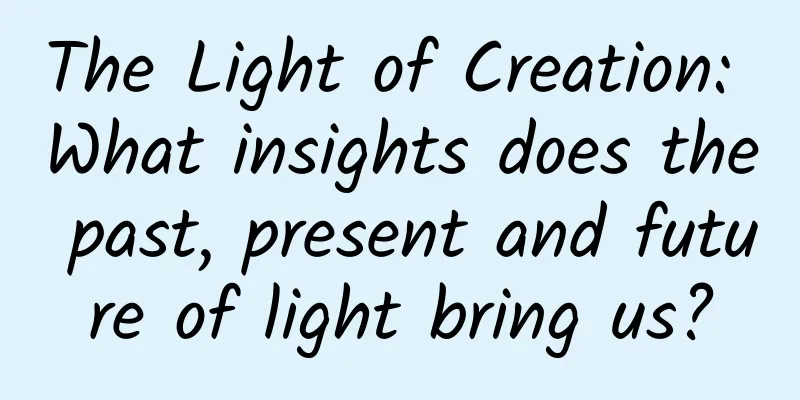The Light of Creation: What insights does the past, present and future of light bring us?

|
Light is so common and yet so special. It is everywhere, and people can't even feel its existence. Only when it disappears do we realize how precious it is. During the day, the world is filled with light, and at night there is moonlight, starlight, and lights. Only in a darkroom that is covered tightly does the light disappear. In that world without light, it seems that everything has disappeared. Before the advent of science, no one thought about or explored where light came from and where it went. It seemed that it had always existed, with no past and no future. As people's understanding of light became more and more profound, they discovered that light had so many wonderful personalities. In a sense, it is light that created the world we know, and will eventually disappear with the destruction of the world. Now let's learn about the past, present and future of light, and what enlightenment it brings to us. Light of Creation/ The standard cosmological model recognized by the scientific community believes that the Big Bang occurred 13.8 billion years ago, and an asymmetric singularity appeared in the vacuum quantum fluctuations, and the singularity exploded and gave birth to the universe. Before the Planck time of the Big Bang, that is, 100 billion billion billion billionths of a second (10^-43 seconds), the universe was infinitely hot, infinitely dense, and infinitely small, a world that human physical laws could not understand. Human beings' understanding of the universe, or possible understanding in the future, after the Planck time, is that the universe has expanded to the Planck scale, which is 100 billion billion billionths of a meter (1.6*10^-35 meters); the temperature has dropped to the Planck temperature, which is 100 billion billion billion K (10^32K); and the density has dropped to 100 billion billion billion billion billion billion billion billion grams per cubic centimeter (10^94 grams/cm^3). After the Planck time, the four fundamental forces that govern the world began to appear one after another, and subatomic particles also appeared one after another as the universe continued to cool. But for a long period of time, the universe was still in a high-temperature and high-density state, and electromagnetic radiation, that is, the collection of light, could not escape. Therefore, the universe at that time was dark and opaque. It was not until 380,000 years later that the temperature of the universe dropped to 3000K, and electromagnetic radiation was decoupled, and the universe radiated the first light. From then on, the universe began to become transparent, and the electrons, protons, and neutrons that had long been floating in the particle soup began to synthesize the simplest atoms, and real matter began to appear. Therefore, it can be said that the appearance of light has given rise to the world observed by humans today. In theory, light is the manifestation of matter being transformed into energy, and all matter today is transformed from the energy of the Big Bang. Light shapes the colorful world/ In essence, light is electromagnetic radiation, a form of propagation of cosmic energy. The light we usually refer to is visible light, which is light that the human eye can perceive, and is a very small fragment of electromagnetic radiation. The wavelength of electromagnetic radiation ranges from attometres (10^-18 meters) to kilometers, of which visible light only occupies a small section of 380 nanometers to 760 nanometers. Before and after the visible light band, there are radio waves with the longest wavelengths (including long waves, medium waves, short waves, and microwaves), with wavelengths ranging from several kilometers to 1 millimeter; there are also infrared rays, with wavelengths between 760 nanometers and 1 millimeter; electromagnetic radiation with shorter wavelengths than visible light includes ultraviolet rays, X-rays, and gamma rays, each with shorter wavelengths than the other, with the shortest gamma ray wavelength being less than 0.1 nanometers, all the way up to the atm level, or even shorter. These electromagnetic radiations can all be called light, because their transmission medium is photons. However, humans cannot see other electromagnetic radiations except visible light. These invisible low-energy and high-energy lights can be called invisible light. Although the human eye cannot see electromagnetic radiation other than visible light, it is possible to receive or "see" these invisible lights through various modern scientific instruments and equipment, such as oscilloscopes, electromagnetic radiation measuring instruments, radio and ray telescopes, X-ray machines, etc. Humans have relied on these lights to perceive and "see" the world since ancient times. This is because visible light is the most basic condition for the growth and survival of life on Earth, and humans and many animals have evolved a visual system that is sensitive to visible light in order to adapt to the Earth's environment. Visible light, such as sunlight, looks white, or colorless and transparent. In fact, sunlight is not colorless, but a composite color. This composite light is a gradual change from red to purple, and can be divided into countless color differences. People generally divide it into seven colors: red, orange, yellow, green, blue, indigo and violet, and each color has a different wavelength. Among them, red light has the longest wavelength, approximately between 625 and 760 nanometers; orange light has a wavelength range of approximately 590 to 625 nanometers, yellow light has a wavelength range of approximately 570 to 585 nanometers, green light has a wavelength range of approximately 492 to 577 nanometers, indigo light has a wavelength range of approximately 420 to 440 nanometers, and blue light has a wavelength range of approximately 440 to 475 nanometers; violet light has the shortest wavelength, approximately between 380 and 440 nanometers. Everything in the world is originally colorless, but different objects have different absorption and reflection rates for light of different wavelengths. The absorbed spectrum cannot be seen by the human eye, and what can be seen is only the light reflected by the object. This is how the world people see presents different colors. Therefore, it is the color of light and the different absorption and reflection rates of objects for light of different wavelengths, or the different angles at which the human eye looks at objects, that create the colorful world. We see leaves as green because they absorb more of other colors of light in the sunlight and reflect more green; we see red objects because these objects absorb more of light of other colors except red and reflect more red; white objects, such as white cloth and white snow, absorb almost no light and reflect it in the form of the full band of visible light. Light has wavelength and frequency, and the frequency is inversely proportional to the wavelength. That is, the longer the wavelength, the lower the frequency; the shorter the wavelength, the higher the frequency. The energy of light waves is inversely proportional to the wavelength and directly proportional to the frequency. The shorter the wavelength and the higher the frequency, the greater the light energy. Therefore, light with a higher frequency than visible light has a stronger lethality, such as ultraviolet rays, X-rays, and gamma rays, which are more powerful than each other and can injure or even kill organisms. Humans use light of different wavelengths and frequencies to seek benefits and avoid harm, transforming the world for the benefit of mankind. The speed of light is a basic tool for humans to understand the world. Before Galileo founded experimental science, people had a vague understanding of the speed of light. Mainstream experts generally believed that the speed of light was infinite, and as long as there was a light source, the light would instantly illuminate the target, and sunlight would instantly fill the world. This understanding is actually not surprising at all, because the speed of light is too fast, and it is impossible to distinguish the speed of light with the science and technology at that time and the naked eye. The great scientist Galileo often conducted some incredible experiments. He dropped two iron balls, one large and one small, from the Leaning Tower of Pisa to see if they would land at the same time, and thus derived the law of free fall. Galileo believed that light has a speed and once tried to measure how fast the speed of light is. He and his assistants stood on two hills one mile apart, holding up lanterns as a signal to try to calculate the speed of light between the two hills. He greatly underestimated the speed of light, so he chose such a simple method, and the experiment ended in failure. How could the speed of light, which is about 300,000 kilometers per second, be seen by the naked eye within a mile? But Galileo's experiment influenced generations of scientists who racked their brains to design and manufacture various instruments and equipment to measure the speed of light. From rough to fine, the speed of light gradually became clear. The precise value of the speed of light was finally obtained by the scientific method of laser interferometry in the 1970s. Later, the International Committee of Weights and Measures revised the length of the meter and used the speed of light to determine the length of the "meter", so that the unit of length and the speed of light could be mutually confirmed, and finally the integer value of the speed of light was obtained, namely: the speed of light in vacuum c = 299792458 meters per second. Since then, the speed of light c has become a basic constant in modern physics, and has been involved in almost all areas of science and technology. As the understanding of the speed of light has become more and more accurate over the past few hundred years, human beings have also become more and more accurate in their understanding of the universe. In cosmic observation, the speed of light has become a cosmic ruler, a unit for measuring the distance of distant celestial bodies. This is the light year. The distance light travels per second is 299,792,458 meters, 3,600 seconds per hour, 24 hours per day, and a Julian year is 365.25 days, so a year is 31,557,600 seconds; the distance light travels in a Julian year is 94,607,304,725,808 meters, which is about 9.46 trillion kilometers, which is the scale of a light year. Since light has a speed, and everything in the world that the human eye sees relies on light to be transmitted to the retina, the closer the object is, the shorter the time it takes to reach the human eye; conversely, the farther the object is, the longer it takes to reach the human eye. In this way, all objects that humans see are not their immediate appearance, but their appearance in the "past". For example, an object at a distance of 1 meter takes 299,792,458ths of a second to reach our retina, so the object we see is what it looked like 299,792,458ths of a second ago; similarly, an object at a distance of 1 kilometer looks like it looked like 299,792.458ths of a second ago. The moon is about 384,000 kilometers away from us, and the speed of light is about 300,000 kilometers per second, so the moon we see is what it looked like more than one second ago. For objects that are very close, the time required to reach our eyes is extremely short, so it can generally be ignored and regarded as instantaneous. However, for objects that are far away, it takes enough time to reach our eyes, which has a time delay meaning. For example, the sun is 150 million kilometers away from us, and the light radiation it emits takes more than 8 minutes to be transmitted to the earth. Therefore, the sunlight shining on us is always the light emitted by the sun more than 8 minutes ago; and the stars or galaxies that are 1 light year or 100 million light years away from us, what we see will always be the same as they were 1 light year ago or 100 million years ago, and so on. Light was born in creation, will it eventually disappear? Light is both the manifestation of matter being transformed into energy and the medium for transmitting energy. Therefore, it can be said that without light, there is no energy. Everything in the universe needs energy to maintain. Without energy, everything will perish. For life on Earth, there is a saying that everything grows with the sun. Without the sun, all life on Earth will disappear. First of all, without sunlight radiation, the earth will become an ice ball with a temperature of more than 200 degrees below zero, and everything will be frozen; before freezing, all plants that rely on photosynthesis to grow will die, and herbivores that rely on plants for survival will become extinct. Then carnivores that rely on eating the meat of herbivores for survival will also die, and finally even microorganisms will die, and life will become extinct on Earth. For life, too little light means it cannot survive, and too much light means it cannot survive either. During billions of years of evolution, life on Earth has adapted to the visible light of the sun, which allows plants and animals to thrive. However, the universe and the sun do not only emit visible light, but also ultraviolet rays, X-rays, gamma rays and high-energy cosmic rays, which are the biggest enemies of life. Some studies have suggested that the mass extinction of species in the Ordovician period 445 million years ago was caused by gamma-ray bursts. Two neutron stars 6,000 light years from Earth collided, causing a supernova explosion that sent out several gamma-ray bursts, one of which happened to pass over Earth, causing the food chain to break. After more than 400,000 years of extinction disaster, 85% of species disappeared. Nowadays, solar wind, ultraviolet rays and cosmic rays are bombarding the earth every moment, but the earth has two layers of armor protection: one is the geomagnetic field, which guides the strong solar wind from the sun to distant places; the other is the atmosphere, especially the ozone layer, which blocks and filters the ultraviolet rays from the sun and most cosmic rays. So, if light is created from nothing, will it disappear in the future? The answer is yes. Based on modern science's explanation of the universe, the universe and time are relative, with a beginning and an end, so everything will eventually die out. But this time is very long, so long that humans cannot see it. There are many speculations about the fate of the universe, including heat death, big collapse, big rip, etc. These are long stories. Friends who are interested can refer to the relevant articles in the past of Spacetime Communication. I will not go into details here. But no matter what kind of demise, spacetime will eventually disappear and return to nothingness, and light is no exception. What do you think about this? Welcome to discuss and comment. The original copyright of Space-Time Communication is reserved. Please do not infringe or plagiarize. Thank you for your understanding and support. |
<<: Why is frozen shrimp so unpalatable? You are missing these steps
>>: Did you order this tripe or that tripe?
Recommend
Practical experience in information flow: detailed analysis of the three core influencing factors of an account!
"I know there is a problem with my account, ...
Decoding the power of Snapchat from my social product syllogism
Snapchat is finally going public. The company has...
If I have a cold or flu, will the nucleic acid and antigen tests be positive?
[This issue's rumors]: Recently, there has be...
Intel betrays its teammate: Apple MacBook Pro has no graphics card available
From the beginning of last year to now, I don'...
How rare are black panthers in Africa? Only one has been photographed in more than 100 years
In many people's minds, black cats are always...
International Polar Bear Day丨How can they survive in the gradually warming Arctic?
Today, February 27, is International Polar Bear D...
What does an excellent event operation data report look like?
Without data, operations cannot know the effectiv...
Home central air conditioning is a tough nut to crack
From the perspective of home air conditioner manu...
Apple Pay: Apple's payment ambitions
This time, money was directly used and Jobs was n...
6 routines and 3 dimensions for B2B operators to attract new customers!
For 2B operators, attracting new customers means ...
Content operation, how does Bilibili operate the UP host group?
This article mainly analyzes BiliBili’s product i...
China Automobile Dealers Association: Regional market analysis of new energy passenger vehicles in March 2022
According to the China Passenger Car Association&...
Zap&Go power bank comes out and can charge iPhone 5s in five minutes
Nowadays, mobile power banks have become one of t...
The most comprehensive online and offline promotion guide for mini programs!
As mini programs become more and more sophisticat...









